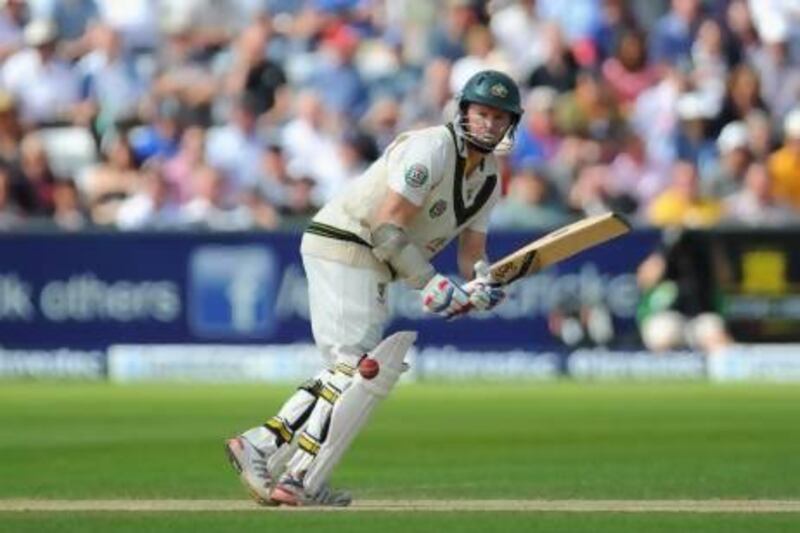No matter what happens at Durham over the next couple of days, much of the Ashes Test-match chatter will be centred on Chris Rogers, who played and missed, and then played and missed some more, on his way to a first century, days before he turns 36.
Having made his first-class debut in 1998, no one can accuse Rogers of taking the easy way to the top. It took him almost a decade to win his first Test cap – against India at Perth in January 2008.
Rogers, who is both colour-blind and near-sighted, made just four and 15 in that game, and lost his national contract at the end of the season. Despite moving from Western Australia to Victoria and piling on the runs subsequently, it appeared as though he would always be remember as a one-cap wonder.
Rogers himself seemed accepting of his fate, if an ESPN article critiquing Australia's modern-day batsmen from April 2012 was any guide.
In the wake of the hundred from Rogers, there was plenty of ill-informed comment about Australia's selectors for having left him on the outside for so long.
Such individuals forgot that it is not normal to recall someone nearly 36. It is certainly not something Australian cricket has done in times of plenty, and is an indictment of how bare the larder is now.
So, has Rogers been unlucky?
Has he been a victim of capricious selection?
In a word, no. To know how good he is, you only need look at the list of those who have made the most centuries in the Sheffield Shield, Australia's first-class competition that was for long held up as the model to follow for everyone else.
Rogers lies sixth in the table, with 30 centuries and more than 9,000 runs. Look above him though, and there is only one bonafide Test legend in the top five – a certain Donald George Bradman.
Each of the others has a hard-luck story of their own.
Darren Lehmann coaches Australia now, but in his former guise, he made 45 Shield centuries while amassing 13,635 runs at 54.97. He did not become a Test regular until he was well into his 30s and finished with 27 Test caps.
Michael Bevan, second on the list with 42 hundreds, never quite cracked the Test code despite being a master of the one-day international format. He made his debut in a remarkable Test match against Pakistan in 1994 – Inzamam-ul-Haq and Mushtaq Ahmed won it with a last-wicket stand of 57 – and played the last of his 18 games less than four years later.
Yet, despite the weight of first-class runs, there would be no second chance.
Matthew Elliott and Dean Jones have similar tales. Elliott made two brilliant hundreds on the 1997 Ashes tour, but a retiring nature and his innate nervousness appeared to go against him once Steve Waugh took over captaincy of the national side.
There was a one-Test comeback against Sri Lanka in 2004, the last of the 21 occasions in which he wore the baggy green cap.
Jones did so 52 times, but was dropped when he was 31 and still averaging 47 in the Test arena.
Looking down this list of Shield heroes is like walking through the graveyard of broken dreams.
Jamie Siddons – one one-day cap in a career that spanned 15 seasons. Jamie Cox – no such consolation. Brad Hodge – six Tests, one of which included a double-century against South Africa. Martin Love – five appearances, with one century.
And then there was the man who averaged infinity, who made his debut in the same Test as Ricky Ponting.
Ponting made 96, the new boy made 54 not out, and Australia won by an innings in Perth. Steve Waugh, who had missed the Test, would return for the Boxing Day game and make 131. At Adelaide, he scored 170 and 61 not out and added a game-clinching four wickets for good measure.
Stuart Law, the first Queenslander to lead the state to Shield glory, would not play another Test for Australia. Ponting would sign off with 168. At nearly 40, Law was still punishing county attacks for Lancashire. But like Love, Cox and many others, he knew that the lack of baggy green on the mantelpiece had little to do with his inadequacies and everything to do with a golden generation of Australian batting.
It took Damien Martyn more than six years to get back into the side after being dropped for a poor stroke against South Africa at Sydney in 1994.
Matthew Hayden spent nearly half a decade on the outer and still finished with 30 Test hundreds.
Rogers is playing now because the golden generation are long gone. His story, like Michael Hussey's, is not a tale of a talented individual being hard done by. It's repeated ad nauseam that Hussey made 15,000 first-class runs before getting his break.
And so he did. But his Shield record with Western Australia – 8,007 runs at 41.06, and 16 centuries – was nothing exceptional in an era of titans. He had to wait because he was not good enough.
Follow us
[ @SprtNationalUAE ]





